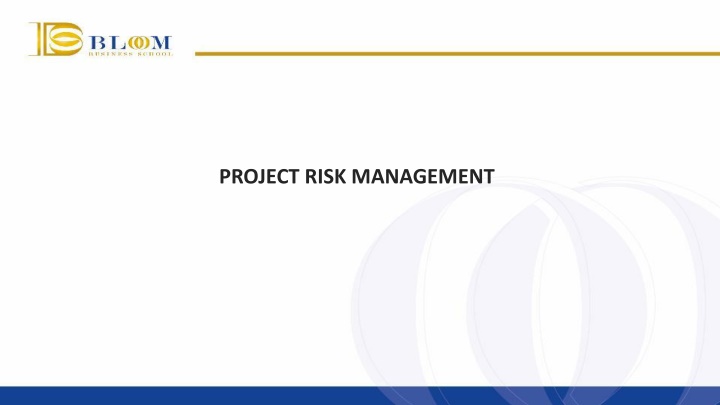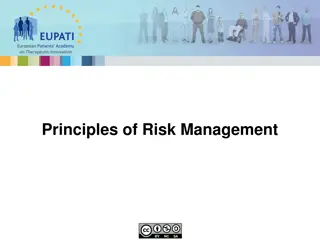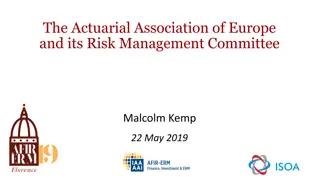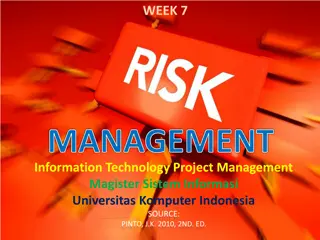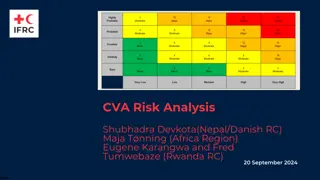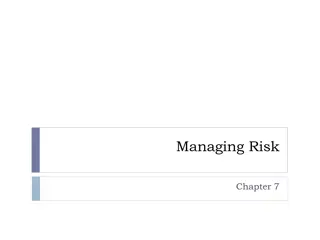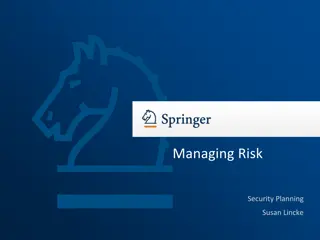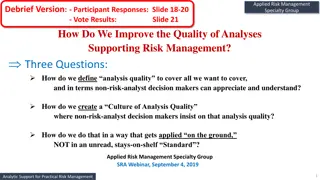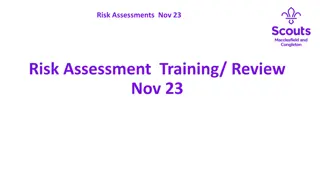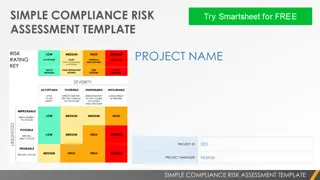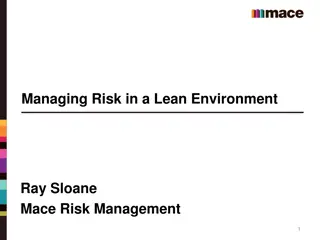Project Risk Management Overview
Project risk management involves conducting a risk management plan, identifying, analyzing, and responding to risks to optimize project success. It includes various processes such as risk planning, response implementation, and monitoring. Risks can have positive (opportunities) or negative (threats) impacts on project objectives. Integrating risk with other project management functions is vital for communication, scope integration, and ensuring project success. Risks are uncertain events that can impact project objectives either positively or negatively. It's essential to consider individual project risks as well as the overall project riskiness.
Download Presentation

Please find below an Image/Link to download the presentation.
The content on the website is provided AS IS for your information and personal use only. It may not be sold, licensed, or shared on other websites without obtaining consent from the author.If you encounter any issues during the download, it is possible that the publisher has removed the file from their server.
You are allowed to download the files provided on this website for personal or commercial use, subject to the condition that they are used lawfully. All files are the property of their respective owners.
The content on the website is provided AS IS for your information and personal use only. It may not be sold, licensed, or shared on other websites without obtaining consent from the author.
E N D
Presentation Transcript
Project Risk Management Events $ % Risk value 25 $ H 2 M $ 1 L 2 100K $ H 3 300K $ 4 L 90% 5 500K $ 500 $ Flat Tire 6 7 M 800K $ 8 H 1 M $ 9 2 M $ L --- 1.2 M $ --- 5% H 1.5 M $ L 35 1.8 M $ 500 $
Project Risk Management Includes the process of conducting risk management plan, identification, analysis, response planning, response implementation, and monitoring risk on the project. The objectives of project risk management: Increase the probability and/or impact of positive (opportunities) risks and decrease the probability and/or impact of negative risks (threats), in order to optimize the chance of Project success.
Project Risk Management Planning 11.1 Plan Risk Management 11.2 Identify Risk 11.3 Perform Qualitative Risk Analysis 11.4 Perform Quantitative Risk Analysis 11.5 Plan Risk Response Execution 11.6 Implement Risk Responses Controlling 11.7 Monitor Risk
Integrating Risk With Other Project Management Functions Communication Scope Integration Expectation Life cycle Data Exchange Accuracy Enviro. Variables Requirements Availability Quality Project Risk Recourses Standards Productivity Time Cost Services Performance Objectives Objectives Time Cost Procurement
RISK An uncertain event or condition that, if it occurs, has a Positive or Negative effect on a project objective. The severity of any risk can be defined in terms of two quantities: Likelihood: The extent to which the risk effects are likely to occur. Impact (Consequence): The effect that a risk will have on the project if it occurs.
RISK Risk exists at two levels within every project. Each project contains individual risks that can affect the achievement of project objectives. It is also important to consider the riskiness of the overall project, which arises from the combination of individual project risks and other sources of uncertainty. Individual Project Risk Overall Project Risk
RISK Project resilience Right level of budget and schedule contingency Flexible project process Empowered project team that has clear objective Frequent review of early warning sign Clear input from stakeholders Integrated risk management Program and portfolio
Risk Management Plan Describes how risk management activities will be structured and performed, and it may include the following elements: Risk strategy Methodology Roles & Responsibilities Funding Timing Risk categories
IdentifyRisk Identify risk is the process of identifying individual project risks as well as sources of overall project risk, and documenting their characteristics. The key benefit of this process is the documentation of existing individual project risks and the sources of overall project risk. It also bring information so the project team can appropriately to identified risk.
IdentifyRisk Risk is doing business Organization External Environment project Environment Significant Factors Location of the site Client Wars
IdentifyRisk SWOT Analysis This technique examines the project from each of the strengths, weaknesses, opportunities, and threats. Internal Factors Externalfactors Strengths (S) Weaknesses (W) Opportunities (O) (SO) Growth (WO) Cooperate Threats (T) (ST) stability (WT) Mitigation
Perform Qualitative Risk Analysis Perform Qualitative Risk Analysis Is the process of prioritizing individual project risk for further analysis or actions by assessing the probability of occurrence and impact and as well as other characteristics. The key benefit of this process is that it focuses efforts on high priority risks.
Plotting Risk Events On The Matrix Risk Impact H M L L M H Risk Probability
Perform Quantitative Risk Analysis Perform Quantitative Risk Analysis is the process of numerically analyzing the combined effect of identified individual project risks and other sources of uncertainty on overall project objective. The key benefit of this process is that it quantifies overall project risk exposure, and it can also provide additional quantitative risk information to support risk response planning.
Quantitative Risk Analysis Probability and Impact Matrix Risk Score for a specific Risk Probability Threats Opportunities 0.72 0.36 0.18 0.09 0.05 0.9 0.05 0.09 0.18 0.36 0.72 0.56 0.28 0.14 0.07 0.04 0.7 0.04 0.07 0.14 0.28 0.56 0.40 0.20 0.10 0.05 0.03 0.5 0.03 0.05 0.10 0.20 0.40 0.24 0.12 0.06 0.03 0.02 0.3 0.02 0.03 0.06 0.12 0.24 0.08 0.04 0.02 0.01 0.01 0.1 0.01 0.01 0.02 0.04 0.08 0.80 0.40 0.20 0.10 0.05 Impact 0.05 0.10 0.20 0.40 0.08
Perform Quantitative Risk Analysis This Process used technique such as Monte Carlo Simulation and Decision Tree Analysis to: Quantify the possible outcomes for the project and their probabilities. Assess the probability of achieving specific project objectives. Identify risks requiring the most attention by quantifying their relative contribution to overall project risk. Identify realistic and achievable cost, schedule or scope targets, given the project risks. Determine the best project management decision when some conditions or outcomes are uncertain.
Plan Risk Responses The process of developing options selecting strategies, and agreeing on actions to address overall project risk exposure, as well as to treat individual project risk. The key benefit of this process is that it identifies appropriate way to address overall project risk and individual project risk.
Plan Risk Responses Risk response should be: Appropriate to the significance of the risk Cost effective in meeting the challenge Realistic within the project context Agreed upon by all parties involved Owned by a responsible person
Risk Response Strategies Mitigation (Corrective action) j0156985 Avoidance (Prevention) Acceptance (Accept consequences) Transference (Shift Responsibility)
Implement Risk Responses Implement Risk Responses is the process of implementing agreed upon risk response plans. The key benefit of this process is that it ensures that the agreed upon risk responses are executed as planned in order to address overall project risk exposure, minimize individual project threats, and maximize individual project opportunities.
Implement Risk Responses Residual Risk The Risks That Remain After Risk Responses Have Been Implemented. Secondary Risk The Risks That Arise As A Direct Result Of Implementing A Risk Response.
Risk Assessment 10 70 ID Event % EGP Plan % EGP Risk Value ( ) 10 40,000 4,000 1 40 140,000 5 ) 2 50 20,000 10 ( 20 4,000 70,000 10 % 600$ 60 $ 1,000 3 60 1,000$ 2,000 10 15,000 50 % 1,500 4 30 35,000 5,000 ) 210,000 50 5 (
